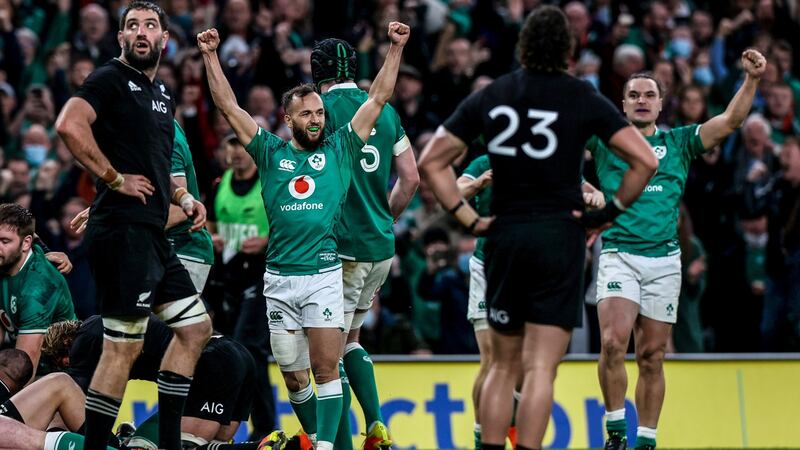Jamison Gibson-Park’s omnipresence might be a little disconcerting for opponents if they paused to try and figure out why he invariably seems to be in the right place at the right time to make the right decision.
The 29-year-old scrumhalf followed up on his brilliant performance in the victory over Japan with another against New Zealand, the country of his birth. A metronome in human form he dictates the tempo of Ireland's attacking patterns, not in isolation by any means, because he needs his pals, particularly in the pack, to provide the platform.
The best scrumhalves are able to hustle to the breakdown without appearing to do so, recognise opportunity and choose the next point of attack. Gibson-Park demonstrates a remarkable capacity to be present at the embryonic stage of a ruck to whip the ball away; not indiscriminately but to a designated recipient.
For the majority of his 71 minutes on the pitch he kept the All Blacks guessing in defence, forcing them to hastily reset, his zippy delivery rarely telegraphing the intended receiver. He invites players onto the ball, keeps the pace high and brings a clever variety to his range of passing. Gibson-Park adds his own nuances to the team playbook.
Once a quieter presence, he now possesses a voice within the Ireland squad, and that degree of comfort or belonging is evident in the manner in which he has run the game beautifully in the last couple of Test matches. He is a primary facilitator for the manner in which head coach Andy Farrell wants the national side to play.
He plays with his head up, scanning and taking in the panorama and rarely would you see him hesitate once he lays his hands on the ball. The optimum ruck speed for an attacking team is under three seconds; if there’s no excavation to be done, he’d be well under that metric.
There were several big ticket items in Gibson-Park’s contribution to the cause during his 71 minutes on the pitch. He led the way with two try assists for those scored by hooker Ronan Kelleher and blindside flanker and man of the match Caelan Doris and on another occasion it was his scrambling defence that denied New Zealand a try.
High octane
He was at the centre of Ireland’s high octane opening in the first 110 seconds of the game and again through his box-kicking which Andrew Conway chased with gusto and to good effect.
On 13 minutes Gibson-Park picks his passes nicely as Ireland muscle their way towards the New Zealand line and when the pick and jam is halted just short, he dug out the ball and sent it fizzing to Sexton. Three passes later and James Lowe beat Jordie Barrett to the try line.
Just before half-time his second try in as many matches beckons following Jack Conan’s inside pass but the ball squirted from his grasp with the line in sight.
Most of what he can do is predicated on the work of his teammates, those who provide the ball and those who line up to carry. The primary demand on Gibson-Park is that he must choose the right option and he did that in the build-up to Kelleher’s try, before popping it to the hooker.

It was even more noticeable on 50 minutes for Doris’s try, the weight and timing of his pass inviting the flanker to step sharply against the grain, brush aside a weak tackle and accelerate to the try line. It’s that awareness that’s been a hallmark of his recent performances.
Two minutes later, Garry Ringrose snaffled a loose ball and on his way to the ruck Gibson-Park appreciated that there was no one home in the New Zealand backfield and his delightful diagonal 50-22 kick gave Ireland a lineout five metres from the All Blacks’ line.
Standout moments
There are other standout moments, holding off Sevu Reece in a footrace to deny the New Zealand wing a try scoring chance following TJ Perenara’s clever grubber kick and a superb relieving clearance kick from inside the Irish 22. The Reece moment wasn’t Gibson-Park’s only good read defensively.
Gibson-Park then demonstrated his game management aptitude on 67 minutes. James Ryan nicked a New Zealand lineout and the scrumhalf threw a 35 metre pass to Hugo Keenan, ignoring a couple of nearer teammates to see if his fullback could find and exploit any space on the counterattack.
The nine jersey belongs to him on the merit of his last two performances but Farrell might be tempted to start Conor Murray against Argentina next Sunday. Having identified a style of play and implemented it successfully it is important to ascertain how well individuals fit into that system.
Can Murray, given a reasonable platform, ensure Ireland play with the same tempo? He deserves a crack to prove that he can as does Craig Casey, who is similar in style to Gibson-Park. It makes sense to give the two Munster scrumhalves some game time next weekend as it does in examining the strength in depth in several other positions.
Gibson-Park was challenged to prove that he could run the game from scrumhalf, first against Japan and then New Zealand. He responded eloquently in the only forum that matters; on the pitch. It’s been a super series both for the team and their scrumhalf.












